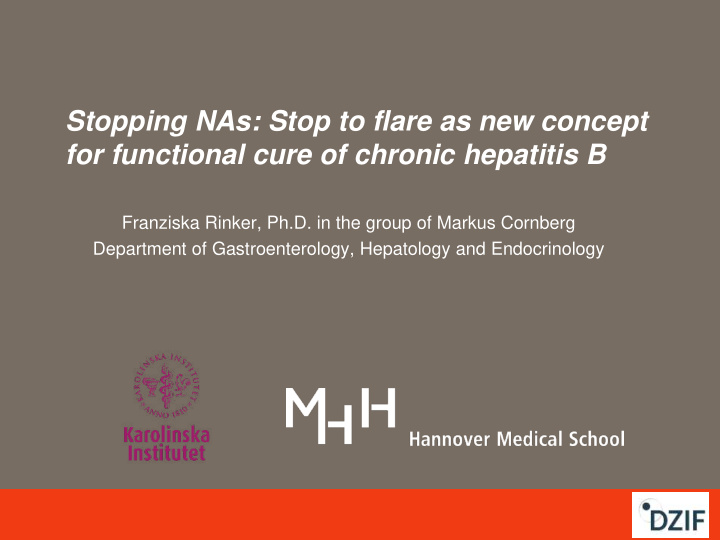



Stopping NAs: Stop to flare as new concept for functional cure of chronic hepatitis B Franziska Rinker, Ph.D. in the group of Markus Cornberg Department of Gastroenterology, Hepatology and Endocrinology
NA therapy in chronic HBV patients Regression of liver fibrosis/cirrhosis 1,2 Potent suppression of viral replication NA therapy w48 w268 BL Reduction of hepatocellular carcinoma incidences 3 However, ... HBsAg loss (clinical cure) is rare (0.33% per year with NA) 4 and takes 30-143 years 5 1 Chang et al., Hepatology 2010 2 Marcellin et al., Lancet. 2013 3 Hosaka et al., Hepatology 2013, Kwon and Lok, Antivir Ther 2011 4 Kim et al., Gut. 2014 Aug;63(8):1325-32. Editorial: Cornberg et al., Gut. 2014 Aug;63(8):1208-9. 5 Chevaliez et al., J Hepatol 2013; 58(4):676-83. Glebe & Bremer, Semin Liver Dis. 2013
Main drawback of NA therapy: cccDNA is not directly effected NAs 1 Fabien Zoulim and David Durantel, Cold Spring Harb Perspect, Med2015;5;a021501
Stopping NA-therapy as a therapeutic concept? • 33 HBeAg negative patients with 4–5 yrs suppression on ADV stopped therapy 13 of 33 (39%) cleared HBsAg during a follow up of of 5.5 years ! Hadziyannis et al., Gastroenterology. 2012 Sep;143(3):629-36
Study design Age: 33-65 yrs 70% Gen D, 30% Gen B+C Fibroscan 5.3 – 11.4 kPa 46% HBsAg <1,000 IU/ml 1.5-3 years at follow up: n=3 HBsAg negative (20%) n=2 anti-HBs positive Höner zu Siederdissen, Rinker, et al., J Infect Dis. 2016
Prospective, randomized study confirms HBsAg decline after stopping TDF therapy T Berg et al., O0119 EASL 2015
Time point of virological relapse (VR) after treatment discontinuation HBV DNA until peak viremia after treatment discontinuation Reanalysis of Höner zu Siederdissen, Rinker, et al., J Infect Dis. 2016
Late relapse after therapy stop with ETV compared to TDF Subjects without Viral Relapse (HBV- DNA ≤ 2000 IU/ml) after NA treatment interruption - Kaplan-Meier curves. >70% relapse ETV patients without viral relapse % patients without viral relapse % TDF < 10% relapse H Wedemeyer et al., ILC 2017; LBP-518
Study design Age: 33-65 yrs 70% Gen D, 30% Gen B+C Fibroscan 5.3 – 11.4 kPa 46% HBsAg <1,000 IU/ml
NK cell natural cytotoxicity is increased after therapy interruption Zimmer, Rinker, et al., submitted 2017
NK cell natural cytotoxicity is increased after therapy interruption Conditions: • K562 cells (natural cytotoxicity) • 721.221 wt cells (natural cytotoxicity) • 721.221 wt cells + Rituximab (ADCC) • IL-12+IL-18 (cytokine response) • IL-12+IL-18 + K562 (cytokine priming + natural cytotoxicity) Zimmer, Rinker, et al., submitted 2017
NK cell multifunctionality is increased after therapy interruption Zimmer, Rinker, et al., submitted 2017
Stop of therapy changed the T cell phenotype CD4 + T cells CD8 + T cells Rinker, Zimmer, et al., manuscript in preparation 2017
Patients with HBsAg loss showed an altered T cell phenotype B HBsAg loss no HBsAg loss HBsAg loss Rinker, Zimmer, et al., manuscript in preparation 2017
Increased T cell responses and multifunctionality after stop of therapy Rinker, Zimmer, et al., manuscript in preparation 2017
Increased T cell responses and multifunctionality after stop of therapy SI>2 CD4+: 10/12 PBMC stimulated with overlapping peptides (HBV core, GenD ) CD8+: 9/12 Rinker, Zimmer, et al., manuscript in preparation 2017
PD-L1 blockade could further augment T cell responses Rinker, Zimmer, et al., manuscript in preparation 2017
Summary – Stopping NA therapy • Treatment discontinuation in HBeAg-negative CHB is safe • It leads to virological relapse in most of the patients • Stop of therapy: …. lead to induction of cytokines .... increased NK cell natural cytotoxicity …. changed the blood T cell phenotype …. induced HBV-specific T cell responses Stopping therapy should be further investigated as a strategy to induce HBsAg decline or even HBsAg loss
Acknowledgements Hannover Medical School: Karolinska Institutet Stockholm: Prof. Dr. Markus Cornberg Assoc. Prof. Niklas Björkström Christine Zimmer Dr. Christoph Höner zu Siederdissen Prof. Dr. Christine Falk Prof. Dr. Michael P. Manns
Recommend
More recommend